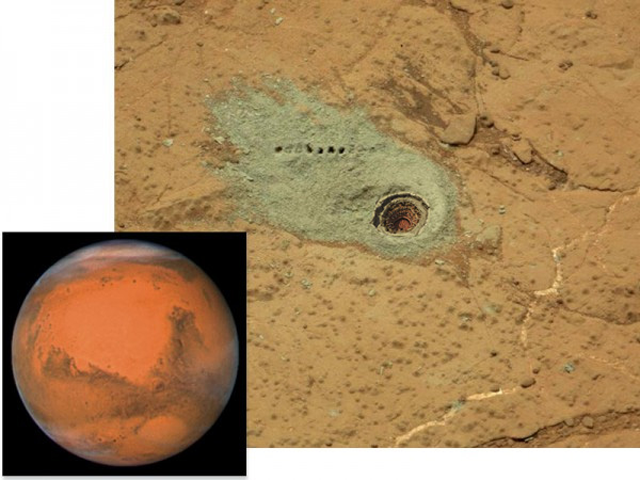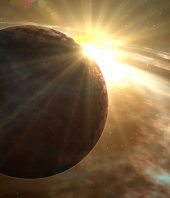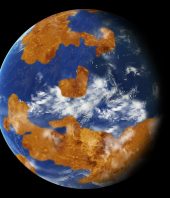When the Curiosity rover landed in Gale crater 16 months ago, its goal was to find a place on Mars that was habitable 4 billion years ago. It has done that, and now a spate of new findings is driving the mission in a new direction: searching for traces of ancient life. Leaders of the 400-strong Curiosity science team say their latest discoveries, published online today in Science, are narrowing down how and where to look for “molecular fossils”—organic matter that might have come from ancient martian microbes.
“Our mission is turning a corner,” says Curiosity project scientist John Grotzinger of the California Institute of Technology (Caltech) in Pasadena. “We are beginning to map a way forward, a way to explore deliberately for organic matter.”
Curiosity’s new analyses of sediment from the bed of a long-vanished lake hint that Mars harbors substantial amounts of organic matter of some sort, although no one is yet willing to attribute it to ancient life. And in a martian first, Curiosity has determined how recently surface rocks have been exposed by erosion. That opens the way to more systematic searches for molecular fossils, by showing scientists how to maximize their chances of finding organic matter that was only recently exposed to the ravaging rain of cosmic rays that pours down on Mars.
The last time Curiosity scientists reported on the hunt for organic matter, things were a bit of a mess. Perchlorate compounds—powerful oxidizers when heated—turned out to be ubiquitous on Mars. And because Curiosity’s onboard test for organic matter involves heating finely powdered rock by hundreds of degrees, any organic carbon compounds would be oxidized to carbon dioxide before the carbon’s original form could be determined. A few molecules did survive, but they seemed to come from a contaminant that leaks into Curiosity’s Sample Analysis at Mars (SAM) instrument package.
SAM team members now report that their contamination problem is behind them. The contamination “can’t explain it all,” says SAM team member Daniel Glavin of NASA’s Goddard Space Flight Center in Greenbelt, Maryland. By analyzing empty sample containers, varying the amount of sample, and flushing out samples before analysis, the SAM team has concluded that the contaminant now accounts for only 1% to 3% of the carbon appearing as carbon dioxide.
The remaining 97% may well have come from martian organic matter. The SAM authors reached that conclusion after Curiosity took its first look beneath the planet’s surface. At a site called Yellowknife Bay, which has a rock outcrop that seems to have been the bottom mud of an ancient lake, the probe drilled 5 centimeters into the rock. The team then compared samples of windblown dust scooped off the surface with samples of rock powder from the borehole. The dust had been exposed to organics-destroying solar ultraviolet, cosmic rays, and radiation-activated perchlorates for many millions of years. The lakebed had long been shielded by encasing rock.
When SAM heated the samples, the lakebed samples emitted more carbon dioxide than equal-size dust samples did, and their carbon dioxide came off at lower temperatures. Those observations suggested that heating the dust had simply decomposed naturally occurring, inorganic carbonate minerals, but that heating the lakebed samples had burned organic matter. Most telling, as carbon dioxide from the lakebed surged, the level of oxygen gas from decomposing perchlorates dropped. On seeing those data, one SAM team member reportedly declared, “This is combustion of organic carbon, folks.”
Curiosity’s Glavin says the results are “exciting,” but he and the rest of the SAM team are more cautious in print. So is organic geochemist Mark Sephton of Imperial College London, who is not on the Curiosity team. The results are “very consistent with organic carbon,” he says, but he adds that so far they are “tantalizing” rather than definitive.
Tempering the excitement is Glavin’s ready admission that “we can’t say anything about the origin of this [organic] carbon.” That’s because a nonbiological source is close at hand: Tons of organic matter fall on Mars every year in meteorites and cosmic dust. Researchers estimate that these organic compounds, made not by living things but by chemical processes in space, could have supplied Mars’s surface with between about 10 parts per million (ppm) and several hundred ppm of carbon—enough at the high end to account for all of the roughly 500 ppm of carbon that Curiosity has detected in the lakebed samples.
What’s more, the ancient environment around Gale crater does not appear to have been very hospitable to life, new analyses reported in the Science papers suggest. The lakebed deposits—which washed into the crater from surrounding high ground—show “very little evidence for chemical weathering” before arriving in the lake, says team member Scott McLennan of Stony Brook University in New York. That suggests that there was little liquid water around to alter the minerals and thus that “we’re dealing with very arid and/or cold environments,” McLennan says. The area may have resembled the hostile, hyperarid Atacama Desert of Chile, where water flows only during rare torrential rainstorms.
The muddy lake bottom might have been more hospitable. In their paper, Grotzinger and his Curiosity colleagues describe the bottom mud there as a “strikingly Earth-like habitable environment.” But to survive in the mud of an oxygen-free planet, any microbes would have had to derive energy from the chemical imbalances between minerals in the sediment—“eating rock” in a process called chemolithotrophy.
On Earth, “fully convincing” chemolithotrophy is known only in kilometers-deep rock exposed in South African gold mines, according to marine geochemist Steven D’Hondt of the University of Rhode Island in Narragansett. And levels of organic carbon there are minuscule compared with the 500 ppm of carbon reported on Mars. So if the martian carbon is indeed organic, the best guess now is that either Curiosity has stumbled across the remains of an unexpected subsurface oasis, or most of the carbon comes from meteorites.
Another of the recent results may make it easier to search for martian carbon—and ultimately sort out its origins. For the moment, carbon-hunters face a serious obstacle: Cosmic rays penetrate the rock down a meter or so, far beyond the reach of Curiosity’s drill, and over millions of years utterly destroy any organic matter.
In one paper, Kenneth Farley of Caltech and colleagues demonstrate an elegant solution: a way to identify rock that has been buried for eons beneath at least a couple meters of protective rock and only recently exposed by wind erosion. Using SAM’s mass spectrometer, they measured isotopes of helium, neon, and argon that cosmic rays generate as they pass through rock. The fewer of these isotopes they find, the more recently the rock has been exposed near the surface. Using the technique, they show that the 4-billion-year-old lakebed rock drilled by Curiosity was uncovered between 30 million and 110 million years ago as winds sandblasted away 2 meters of overlying rock. An ideal drill site would be tens of millions of years fresher, but it’s a start.
“It gives us a rational way to look for organics on Mars,” Grotzinger says. So next time, Curiosity’s handlers will just look for a sign of recent wind erosion, such as a step up in the rock, nuzzle the rover up to the step, and see just how freshly exposed the rock is. Voilà: a whole new approach to prospecting for past life on the Red Planet.
Source: AAAS
Link: http://news.sciencemag.org/chemistry/2013/12/new-results-send-mars-rover-quest-ancient-life






